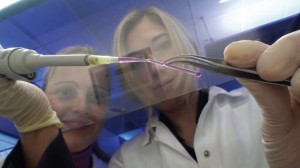Doctors have been successful in replacing dead intestines and tracheas, designed by tissue engineers. But, the same process on larger organs has been a little slow as they could not design blood vessels like capillaries that deliver the wanted nutrients to the other tissues. If the nutrient supply is stopped or cut-off at intervals, the tissues will not live for a long time. A engineering research team from the Fraunhofer Institute for Interfacial Engineering and Biotechnology IGB in Germany have finally found a solution by printing the capillaries with the help of a 3-D printer.

The basic element behind the 3-D printer is the special ink that contains synthetic polymers, as well as bio-molecules. Due to the unique characteristics of these materials, the artificial tissues produced are easily accepted by the body. The inks react chemically and form into an elastic solid, and thus help the tissue engineers to design highly precise three-dimensional structures.
To build such a material, the researchers were in need of an extra layer of precision to build the fine, feathery structures to serve as capillaries. So, they decided to use two-photon polymerization method. The method uses intermediate, high intensity laser light blasts, which stimulate finely tuned molecular cross-linking. After the completion of the tiny walls, the inner walls are developed by seeding the vessels with endothelial cells.
There have been many unsuccessful efforts in the past to grow artificial blood vessels. Some of them include the use of gel matrices, and also hammering a nail into an electrified plastic block. Both these methods have made fine tubes through which the fluid can flow. This new method is another way to precisely control the structures’ formation.
The experiments conducted being successful, the researchers have began progressive works in building artificial organs, vascularized with this new printing method. With the existing technology, even though the transplantation of synthetic organs to the human body is impossible, they could at least be used to experiment new drugs or therapies, replacing animal subjects in clinical studies. Transplanting synthetic organs is still farther into the future, the Fraunhofer team says.

1 Comment
Thanks a lot for this amazing and wonderful invention .